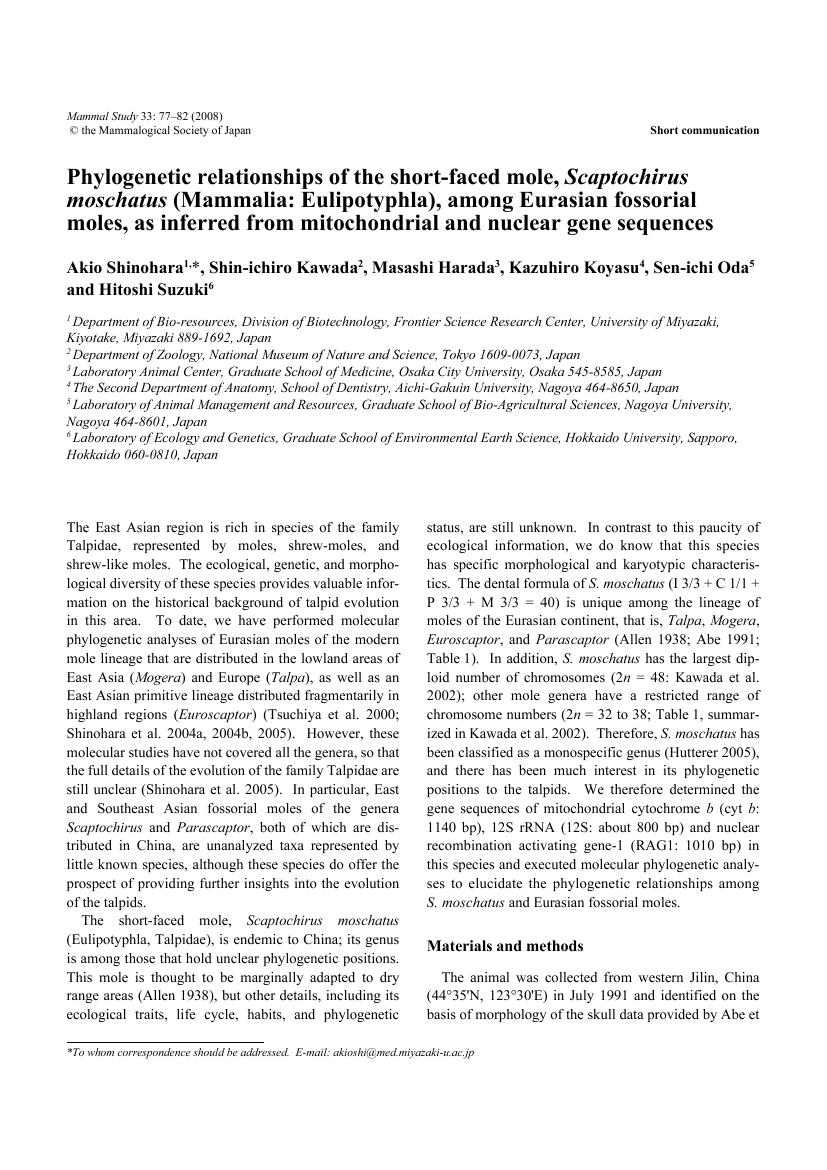- 著者
- Tetsuji Hosoda Hitoshi Suzuki Masashi Harada Kimiyuki Tsuchiya Sang-Hoon Han Ya-ping Zhang Alexei P. Kryukov Liang-Kong Lin
- 出版者
- The Genetics Society of Japan
- 雑誌
- Genes & Genetic Systems (ISSN:13417568)
- 巻号頁・発行日
- vol.75, no.5, pp.259-267, 2000 (Released:2002-09-19)
- 参考文献数
- 39
- 被引用文献数
- 55 67
We compared partial sequences (402 bp) of the mitochondrial cytochrome b gene in 68 individuals of martens (Martes), weasels (Mustela) and their relatives from the Northern Hemisphere to identify the modes of geographic differentiation in each species. We then compared complete sequences (1140 bp) of the gene in 17 species of the family Mustelidae to know the spatial and temporal modes of speciation, constructing linearized trees with transversional substitutions for deeper lineage divergences and with transversions and transitions for younger lineages. Our data suggested that these lineages of Martes and Mustela differentiated in a stepwise fashion with five radiation stages from the generic divergences (stage I) to the intraspecific divergences (stage V), during the last 10 or 20 million years as the fossil evidence suggests. In the lineage of Martes, the first offshoots are of Martes flavigula, M. pennanti, and Gulo gulo (stage II), the second is M. foina (stage III), and the third are M. americana, M. martes, M. melampus, and M. zibellina (stage IV). The divergence of the lineages of Mustela is likely to have taken place concurrently with the radiations of the Martes. These divergence processes are attributable in part to the geographic allocation along the two continents, North America and Eurasia, as well as among peripheral insular domains, such as Taiwan and the Japanese Islands. In addition, the Eurasian continent itself was shown to have been involved in the species diversification in the martens and weasels.
1 0 0 0 OA Development and Application of Analytical Methods for Chiral Amino Acids and Related Metabolites
- 著者
- Sachise KARAKAWA Masashi HARADA Rumi NISHIMOTO
- 出版者
- The Society for Chromatographic Sciences
- 雑誌
- CHROMATOGRAPHY (ISSN:13428284)
- 巻号頁・発行日
- vol.44, no.1, pp.21-26, 2023-02-20 (Released:2023-03-11)
- 参考文献数
- 47
- 被引用文献数
- 3
Three different types of analytical methods for D,L-amino acid were developed. First, a method for simultaneous analysis of D,L-amino acids in food was constructed by combining pre-column derivatization with 4-fluoro-7-nitro-2,1,3-benzoxadiazole (NBD-F), UHPLC separation, and UV and circular dichroism (CD) detection. Using this method, D,L-amino acids in food samples was determined at a very short time of 5.5 minutes. Second, a pre-column derivatization LC/MS method (direct method) for D-alanine, D-serine, and D-aspartic acid and L-isomers in biological samples was developed. In this method, D,L-amino acids were derivatized with an achiral reagent, p-N,N,N-trimethylammonioanilyl N′-hydroxysuccinimidyl carbamate iodide (TAHS), separated with a chiral column, and detected using mass spectrometry (MS). Third, a pre-column derivatization LC/MS method (indirect method) for highly sensitive and selective analysis of 20 D,L-amino acids using a chiral derivatization reagent, (R)-4-nitrophenyl-N-[2-(diethylamino)-6,6-dimethyl-[1,1-biphenyl]-2-yl] carbamate hydrochloride ((R)-BiAC), was developed. The unique structure of the (R)-BiAC reagent, which has a biaryl axially chiral structure, allowed for higher resolution and a high sensitive analysis of the 20 D,L-amino acids within 12 minutes. This method has been applied to various D-amino acid research studies, and it can be applied to a wide range of analyses from food to biological samples. Lastly, an LC/MS method was established that simultaneously analyzes tryptophan and 15 of its metabolites, which is involved in neurotransmission and immunity in vivo.
- 著者
- Akio Shinohara Shin-ichiro Kawada Masashi Harada Kazuhiro Koyasu Sen-ichi Oda Hitoshi Suzuki
- 出版者
- 日本哺乳類学会
- 雑誌
- Mammal Study (ISSN:13434152)
- 巻号頁・発行日
- vol.33, no.2, pp.77-82, 2008 (Released:2009-07-04)
- 参考文献数
- 39
- 被引用文献数
- 9
